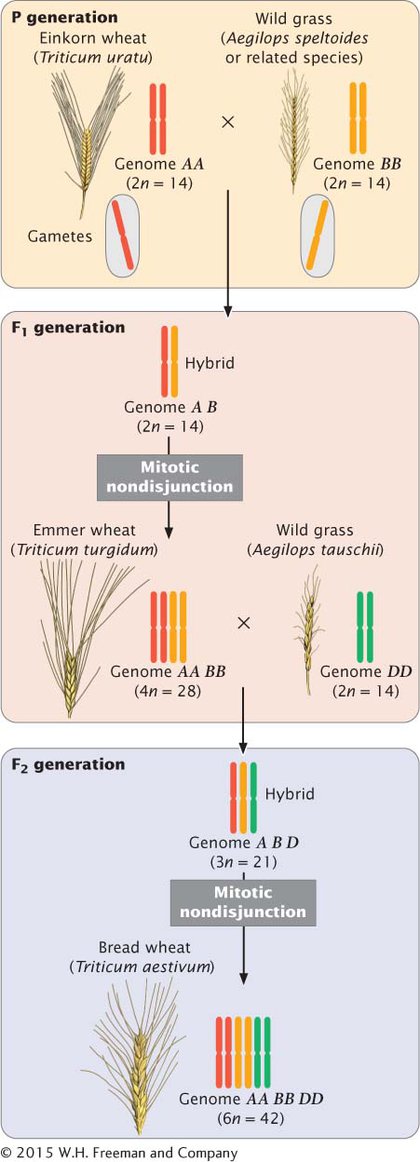The Significance of Polyploidy
In many organisms, cell volume is correlated with nuclear volume, which in turn is determined by genome size. Thus, the increase in chromosome number in polyploidy is often associated with an increase in cell size, and many polyploids are physically larger than diploids. Breeders have used this effect to produce plants with larger leaves, flowers, fruits, and seeds. The hexaploid (6n = 42) genome of wheat probably contains chromosomes derived from three different wild species (Figure 6.26). As a result, the seeds of modern wheat are larger than those of its ancestors. Many other cultivated plants also are polyploid (Table 6.2).

| Plant | Type of polyploidy | Chromosome sets | Chromosome number |
|---|---|---|---|
| Potato | Autopolyploid | 4n | 48 |
| Banana | Autopolyploid | 3n | 33 |
| Peanut | Autopolyploid | 4n | 40 |
| Sweet potato | Autopolyploid | 6n | 90 |
| Tobacco | Allopolyploid | 4n | 48 |
| Cotton | Allopolyploid | 4n | 52 |
| Wheat | Allopolyploid | 6n | 42 |
| Oats | Allopolyploid | 6n | 42 |
| Sugarcane | Allopolyploid | 8n | 80 |
| Strawberry | Allopolyploid | 8n | 56 |
|
Source: After F. C. Elliot, Plant Breeding and Cytogenetics (New York: McGraw- |
|||
Polyploidy is less common in animals than in plants for several reasons. As discussed, allopolyploids require hybridization between different species, which happens less frequently in animals than in plants. Animal behavior often prevents interbreeding among species, and the complexity of animal development causes most interspecific hybrids to be nonviable. Many of the polyploid animals that do arise are in groups that reproduce through parthenogenesis (a type of reproduction in which the animal develops from an unfertilized egg). Thus, asexual reproduction may facilitate the development of polyploids, perhaps because the perpetuation of hybrid individuals through asexual reproduction provides greater opportunities for nondisjunction than does sexual reproduction. Only a few human polyploid babies have been reported, and most died within a few days of birth. Polyploidy—